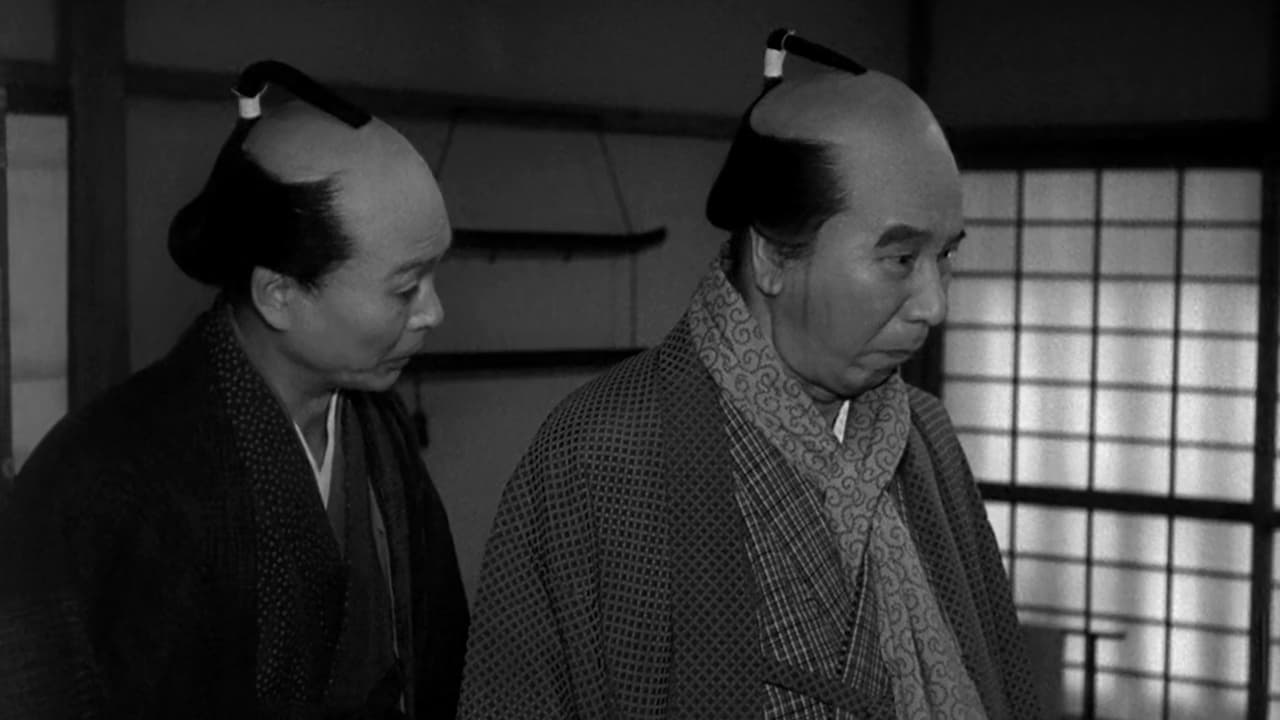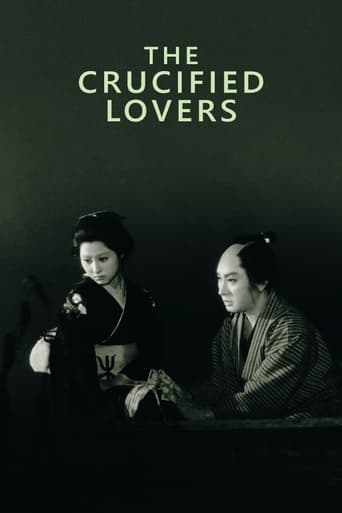



The greatest movie ever made..!
Good concept, poorly executed.
it is the rare 'crazy' movie that actually has something to say.
View MoreOne of those movie experiences that is so good it makes you realize you've been grading everything else on a curve.
View MoreAn adult tragedy of two pursued lovers during Japan's feudal period. It was a rigid society divided by class and gender. Mohei, a talented and decent scroll maker with a promising future, belongs to the servant class. A relatively minor infraction on his part is turned into a major offense by his nasty employer, and when the Master throws Mohei out and has charges brought against him, the Master's wife happens to discover that the Master has been having "illicit adulterous affairs" on the side.The punishment is literal crucifixion for Mohai, so the Master's wife helps him escape and runs away with him. The unyielding Master Scrollmaker sics the authorities on both of them. The wife is on the verge of suicide, but recovers her desire to live when she discovers that she and Mohai have secretly loved each other for years. She willingly joins Mohai in their journey up hill and down dale and for this she too is charged and faces crucifixion.It's a story for grown up sensibilities because the emotional bonds involved -- not just between the pair of illicit lovers but their friends and relatives -- are intricate. The parents don't want them around because if they're caught hiding the fugitives, they face the same punishment. Everyone is ready to squeal on them because what the lovers are doing is "against the law." The performances are adequate once you accept and get past the Japanese filigrees. The fugitive couple are both fine but some of the supporting players are reaching for the stars.I won't spell out the bittersweet ending. The movie itself is worth catching, filled with tension, intrigue, and action.
View More"A Story From Chikamatsu" (Lit.). Viewed on Streaming. Restoration = nine (9) stars; cinematography = eight (8) stars; subtitles = seven (7) stars; music = two (2) stars. Director Kenji Mizoguchi's fascination with classical literature from and dramas originally written for the Japanese puppet theater (that later became stage plays) during the Edo period couldn't be more obvious. "Chikamatsu" is a pen name (not a place in Japan!) of a playwright who created puppet dramas but is probably best remembered for his domestic plays of love and suicides written in the early 18th Century that seemed to cater to women audiences. Mizoguchi's scenario starts with a purely accidental romantic encounter and continues (through many twists and turns) as a high socioeconomic romantic barrier (between the wife of a wealthy merchant and an employee) slowly dissolves even in the face of institutionalized execution for adultery. Once again, the Director spins a tale where the male protagonist's happiness is derived from a woman's sacrifice and the emphasis (from personal experience?) is on the attraction that some "strong" women have for "weak," impoverished men with close to zero prospects. While this is not a morality photo-play, Mizoguchi stresses (perhaps to the extreme?) that adultery (real or imagined) was a big deal in Japan's Pre-modern Social System. Adultery laws were a bit tricky though. Husbands could have (were expected to have?) unmarried female lovers. Wives who took on male lovers (married or single) were deemed to have committed adultery. Both lovers faced execution for their actions. "Proof" of adultery could be based on heresy, gossip or other circumstantial evidence (and motivated by business jealousy or revenge). The husband and families of adulterers could be thrown in jail and have their assets confiscated. Even villages the adulterers came from could be punished! (It would seem that same-sex adulterous relationships were not legally addressed, since, apparently, they were assumed never to occur!) Criterion's restoration is outstanding! Cinematography is very good (often due to the camera subtly "floating" on a crane. Subtitles are a bit long and often fail to fully capture the Kensai-Ben flavor of line deliveries. Music uses only Japanese instruments. While this may be commendable, performances are uneven with percussion used more to provide irritating acoustic-shocks than to enhance scene richness. Recommended. WILLIAM FLANIGAN, PhD.
View MoreThis is adapted from a work by Chikamatsu Monzaemon, one of the defining writers from the early Tokugawa era. His name often reaches us in the contours of a Japanese Shakespeare and as usually with these Western imports to explain Eastern art, it is mostly a lazy comparison. Unlike Shakespeare who continues to inspire a steady flow of film, Chikamatsu's name has been largely neglected however; there is this, and films by Uchida, Shinoda, and Yasuzo Masumura, 'shunji'/double-suicide stories that were Chikamatsu's forte, each enlivened in its own way by the intensity of vibrant artifice and a story of forbidden passions cleansed by death.So film-wise, the heart of these things has been extrapolated from where centuries of concentrated practice refined them, in the stages of kabuki or bunraku, both of which featured elaborate contraptions for generating illusions. The stage having been set, it was all a matter of achieving a cinematic mobility around it. Shinoda made the most clever simple use of that stage in Double Suicide; he was essentially filming what domestic audiences had enjoyed for centuries on the stage of bunraku as part of unbroken tradition, but trusting our eye to be naturally dislocated the right distance to absorb this as a puzzling modernity. It is not unlike what has happened with Mizoguchi; a visual purity from tradition dislocated, thus obscured, through Western interpretations.But let's backtrack a little. We know that Chikamatsu abandoned kabuki for the puppet theater of bunraku, an author's theater, with pliable actors held on strings and the gods that move the world made visible. There he worked in favour of better integrated audience manipulation, in favour of an idealized realism sprung from the author's mind.So here we have a film about a scroll-maker, himself an artist charged with cultivating idealized images, fighting against the idealized reality he has helped cultivate in a quest for the true love he had all his life sublimated into perfect service.It is very similar to Oharu in this way; the film structured around the tension that rises from characters performing idealized roles and the tortured heart that gives rise to them. There is a master printer who cultivates the image of the noble benefactor but who is a cruel deceiving scumbag. Nobles who act magnanimous in the open but then use their position to barter for money. The rival printer who feigns congratulations or compassion but who is secretly plotting for the imperial position.So this idealized world that Chikamatsu advocated and in a small part helped cultivate, Mizoguchi posits to be a system of organized oppression with victims its own characters.But it is in thrusting through this world of idealized, thus largely fictional appearances, that the two lovers can finally realize feelings that were socially prohibited. In this fictional world true beauty, a love fou, is realized by shedding the artificial. As it turns out, the two of them become the couple they were groomed to be.As usual with Mizoguchi, the narrative on the surface level is never less than obvious. It is clean, disarmingly earnest. It seems like the film does not demand anything of us. But beneath the controlled histrionics, there is a heart of images that beats with abstract beauty.The final image is of the two lovers publicly declaring love by simply standing together. It is again clean but resonates outsid the narrative. Their fate is sealed, but the image no longer cultivated but naturally arisen now has the chance to blossom across the audience of curious onlookers. It is an image with the power to inspire change.Mizoguchi is not a filmmaker I can deem personal. But he's a remarkable study just the same.
View MoreSome time ago, I had the opportunity to attend an Ichibana lecture and demonstration. It was given by those close to emperor and was tailored for westerners. That meant that there were plenty slides that contrasted western flower arranging with this highest Japanese art. The western values all had to do with perfect symmetry, balance, coherent, simple shapes. Each element should be beautiful by itself. Harmonies were all within this lovely melody of perfect pace. Bach.Contrasted with this was the Ichibana we saw constructed before us. Dissymmetries, tension, motion and peace. Some elements were dead, even damaged. The base or container was as likely to be misshapen, even ugly. Where the western arrangements were music, this was life. It had soul, katachi. The whole thing was quite an experience for me and was my most visceral introduction to a corner of Japan that I have since enfolded into my own life and eye. At the root of this is dissymmetry (which is different from asymmetry), the presence of items that have sibling states which are not expressed. It gives a tension that springs, the pumps blood and makes real beauty because it provides space for the definition of beauty.This is one of the reasons I appreciate Kurosawa. He understood this, and is why I eagerly watch recommended Japanese films. And why I came to this. Surely Mizoguchi is one of the most celebrated Japanese filmmakers. But what I'm experiencing with him lacks that katachi, that clean, beauty of tension I wished for. What I see is comparatively western. Oh, the story is traditionally Japanese, and the manner of the story. But everything cinematic is perfectly constructed, balanced. Every frame is a masterpiece of construction, and in three dimensions. Its geometric, its rich, its balanced, every vision. Every bit is lovely, every motion perfect, every jot complemented.Its not Ichibana. Its too pretty to be beautiful. Its too Methodist.Ted's Evaluation -- 2 of 3: Has some interesting elements.
View More